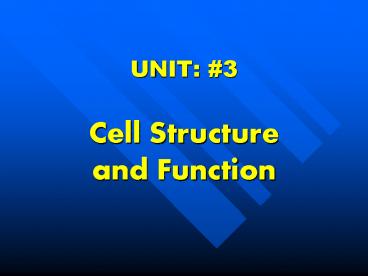Cell Structure and Function - PowerPoint PPT Presentation
Title:
Cell Structure and Function
Description:
UNIT: #3 Cell Structure and Function Organelle Structures of the Cell Organelle: Specialized structure of the cell that carries out a specific function, organ like . – PowerPoint PPT presentation
Number of Views:135
Avg rating:3.0/5.0
Title: Cell Structure and Function
1
UNIT 3
- Cell Structure and Function
2
Organelle Structures of the Cell
- Organelle Specialized structure of the cell that
carries out a specific function, organ like. - The cell is often compared to a factory.
- These organelle structures work to produce a
product.
3
Cell Membrane (Both)
- Composed of several molecules, the most important
is Lipids, which form a bilayer. - The cell membrane separates the cell from its
surroundings. - It regulates what enters leaves the cell.
- Functions protection and support.
4
Cell Wall (Plant)
- Found in Plant, Algae, some Bacteria.
- Is found outside the cell membrane, it actually
surrounds the cell membrane. - It is very porous, allows for water, oxygen,
carbon dioxide and others to pass through it. - The cell wall is both elastic rigid.
- Functions Protection, Support, Regulation.
5
Nucleus (Both)
- Large dark round structure usually in the center
of the cell. - Is known as the information center of the cell.
- Sometimes called the brain of the cell.
- Function To direct all activities of the cell
and store DNA.
6
Nucleolus (Both)
- Made up of RNA and other proteins.
- Function To make ribosomes.
- Nuclear Envelope (Both)
- Two layer membrane that surrounds the nucleus,
Function Acts as border between the nucleus and
the rest of the cell. - Chromosomes (Both)
- The DNA of the cell is stored on the chromosome
inside the nucleus. Shaped like an X. - The chromosome passes genetic information from
generation to generation.
7
Cytoplasm (Both)
- The space or area between the nucleus and the
cell membrane. - Gel or jelly like.
- Function Hold and/or support the organelles.
8
Ribosomes (Both)
- Small particles of RNA and protein found
throughout the cytoplasm. - Function To make proteins.
9
Endoplasmic Reticulum (Both)
- Is an internal membrane system.
- Function It is the site where the lipid
components of the cell membrane are assembled,
along with proteins and other materials. - The part involved in making protein is called the
Rough Endoplasmic Reticulum, it has ribosomes on
its surface. - The Smooth Endoplasmic Reticulum (doesnt have
ribosomes) stores enzymes used to make lipid
membranes.
10
Endoplasmic Reticulum
11
Golgi Apparatus (Both)
- Stack of closely apposed membranes.
- Function It modifies, sorts, and packages
molecules for cell storage or secretion.
12
Lysosomes (Both)
- Small organelles filled with enzymes that act as
a clean-up crew. - Function They digest or breakdown lipids,
carbohydrates, and proteins into smaller
molecules so that they can be used by the cell. - They also break down organelles that have
outlived their usefulness (remove junk that
accumulates in the cell). - Many serious diseases can be traced to lysosomes
that fail to function properly.
13
Lysosome
14
Vacuoles (Both)
- Saclike structure.
- Function stores (warehouse) materials like
water, salt, proteins, and carbohydrates. - Can be found in many different types of cells
(large central vacuole in plants, several smaller
vacuoles in animals). - Play a major role in Homeostasis.
15
Vacuole
16
Chloroplasts (Plant)
- It stores food and pigments.
- Function stores chlorophyll(pigment), which
captures energy from sunlight and converts it
into energy for the cell. - May also be called a Plastid.
17
Mitochondria (Both)
- Function Converts chemical energy stored in food
into energy that is more convenient for the cell
to use. Known as the powerhouse. - Made of two membranes.
- The inner membrane has many folds to increase
surface area to improve their function.
18
Microfilaments (Both)
- Thread like structure made of protein
- Function Helps in cell movement support.
- Microtubules (Both)
- Hallow structure made up of a protein.
- Function Plays a major role in maintaining cell
shape and has a role in cell reproduction.
19
Centrioles(Animal)
- Microtubule bundles
- Function Plays a role in cellular reproduction
20
Cytoskeleton (Both)
- A network of protein filaments that
- Function Helps the cell to maintain its shape.
- It also is involved in movement.
21
Cellular Organization
- Cell (Animal)--gt Tissue (Cardiac)--gt Organs
(Heart)--gtOrgan System(Cardiovascular)--gt
Organisms (Humans)































